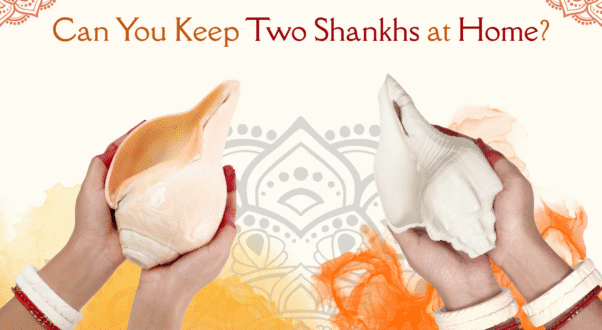
Can You Keep Two Shanks at Home? Vastu Rules Explained
Have you noticed beautifully the vibes you get after the conch shell? From ancient rituals to modern-day puja rooms, Shanks hold a spiritual and sacred place in Hindu culture & Vastu Shastra. Typically, the shanks are symbolic of purity, prosperity, or some decorative piece of art that holds spiritual significance.
Now, the question arises: Is it a good idea to keep a shark at home? Some even incline towards doubts, such as—How to Keep Shank in the Puja Room. Let’s dive into the blog that shares comprehensive guidance on exploring the importance of keeping shanks at home, highlighting their impact in attracting energy and positivity into the environment.
Understanding the Importance of Shank at Home
Shankhs are not commonly referred to as Conch shanks; however, a conch shell is an important and sacred object in various Hindu scriptures, including the Vedas, Puranas, and the Mahabharata. The spiritual depth is connected, as you may have seen, in the depiction of Lord Vishnu and Goddess Lakshmi holding the shank, which symbolises depth.
- Purity and auspiciousness
- The five elements – earth, water, fire, air, and space
- The sound of ‘Om’, the primordial vibration of the universe
Spiritual Benefits of Keeping Shank at Home:
- Invites prosperity and abundance
- Wards off negative energy and the evil eye
- Brings peace, harmony, and spiritual strength
- Improves the Vastu of the house
Whenever blown, the shank produces positive vibrations that purify the environment, kill bacteria in the air, and invite divine energy. Although owning and placing shanks improperly can have a negative impact, according to the Vastu Shastras.

Types of Shanks and Their Vastu Significance
Before we dive into how to place Vamavarti Shankhs or Dakshinavarti Shanks, let’s understand their classification. There are mainly two types of shanks used in homes and temples. It includes-
Dakshinavarti Shank-Right Turning Conch
It’s quite rare and highly auspicious to attract positivity and prosperity. The Dakshinavarti Shank Direction opens to the right (which is south). It’s associated with the Goddess Lakshmi, linked to bring wealth, luck, and fortune.
Vamavarti Shank-Left Turning Conch
This is a commonly found shank that opens towards the left. The shank is associated with Lord Vishnu and used for daily puja and blowing.
Notably, each categorised shankh has its own purpose, symbolising a way to be kept that brings positivity and spiritual harmony.
Can You Keep Two Shanks at Home?
Precisely, you can keep two shanks at home; however, you may need to catch up with specific Vastu rules. This step is crucial to prevent conflict and imbalance between the energies they release into the environment. Each type of shank carries different energies; thus, if not placed correctly, it could cause Vastu doshas or blocked energies, impacting positivity.
Vastu Guidelines for Keeping Two Shankhs:
Use for Different Purposes:
- For daily puja rituals and blowing, one Vamavarti shankh is good to be kept.
- Just as a sacred idol (not for blowing), keep one dakshinavarti shankh in the right direction.
Separate Placement:
- There is a deep importance of the Shankh at home, but you should never place two shanks side-by-side or touch each other.
- To attract prosperity and positivity, keep them on separate stands or pedestals in the puja room.
Energy Alignment:
- Typically, Vamavarti emits Yin—receptive energy. This has an impact on purifying the surroundings.
- Dakshinavarti does emit Yang—active energy within. Thus, it’s good to attract abundance and luck.
It’s a big yes to keep two shanks; it’s a way to attract positivity and prosperity. However, it needs to be done with complete awareness, respecting the Vastu Shastra alignment as described.

How to Keep Shank in Pooja Room: Proper Placement Rules
You may need to be careful when placing the shankh at home in the puja room. The placement has specific guidelines for maintaining cleanliness and usage. The guide below must be followed-
Step 1: Clean the Shank Properly
- Use clean water or milk to purify the shankh before placing it.
- Avoid using soap or chemicals.
- Always wash the shankh before and after every use.
Step 2: Follow Vastu Directions
Let’s dive into the way to place the shank based on its type.
Dakshinavarti Shank Direction (Right-Turning Conch)
- Direction: North or East is best; Southeast (Agni corner) is also acceptable.
- Orientation: Keep the open part facing the puja idol (Lakshmi/Vishnu).
- Placement: On a clean cloth or metal plate, slightly elevated above the surface.
- Usage: Should not be blown. Meant for worship and wealth only.
How to Place Vamavarti Shank (Left-Turning Conch)?
- Direction: East or Northeast is ideal (Ishan corner).
- Orientation: The Mouth should face upward or toward the idol during puja.
- Placement: Can be kept in a holder or small bowl with water.
- Usage: Can be blown during aarti and sacred puja rituals. Produces an Om-like sound.
Step 3: Avoid These Common Vastu Mistakes
- Don’t place the shank directly on the floor.
- Don’t place them near the bathroom or kitchen.
- Never use a broken or chipped shankh.
- Don’t store anything inside the shankh.
Additional Vastu Tips for Shank at Home
Don’t Keep More Than One Dakshinavarti Shankh
No matter that Vamavarti Shankh can be used for multiple blowing purposes, but Dakshinavarti Shank is advised to be used per household to balance energy in the environment.
Offer Flowers and Kumkum Daily
Ensure you worship the shankh like a deity—that gives a deeper connection with positive vibes, especially the Dakshinavarti one.
Blow Vamavarti Shank Twice Daily:
Once in the morning and once at dusk. It purifies the air and improves mental clarity.
Keep the Shank Dry:
When not in use, dry it completely to avoid fungal growth or energy stagnation.
Is It Good to Keep Shank at Home?
Of course, it is good to keep Shank at home—just follow the placement, blowing, and maintenance as a daily ritual. Here are the specified reasons.
Spiritual Benefits:
- Attract positivity and enhance divine vibrations in the home.
- Remove negative and evil influences from the house or its occupants.
- Promote spiritual growth and mental wellness.
Health Benefits:
- The vibrations from the shankh develop positivity into the environment and active inner energies.
- Blowing the shankh during puja rituals daily improves lung capacity.
- Purifies the air and reduces airborne pathogens.
Financial & Emotional Benefits:
- The presence of a dakshinavarti shank is believed to bring unexpected wealth.
- Keeps conflicts, anger, stress, arguments, and negativity away from the family.
What are you waiting for? Stop wondering further about the Importance of the Shank at Home. It’s a resounding yes—if aligned with Vastu rules.
The Final Verdict
From your doubts on how to keep Shank in the Puja Room to placing two at home, everything benefits when done properly. In fact, both Vamavarti and Dakshinvarati Shanks offer luck, prosperity and positivity into life.
It is imperative to place them wisely, according to Vastu Shastra rules, while maintaining cleanliness rituals and respect, to ensure exceptional fortune and energy. To enhance home spiritual harmony, invite fortune, and create positivity at home, the Shankh holds timeless power since the Vedic period.
FAQs
1. How to keep the shank in the pooja room according to Vastu?
Place the vamavarti shankh in the East or Northeast direction, preferably in a holder or small bowl of water. Place the dakshinavarti shank in the North or East direction, facing the idol. Keep them on a clean platform and never directly on the ground.
2. What is the importance of the shank at home?
The shank is considered sacred in Hinduism. It brings spiritual purity, prosperity, health benefits, and aligns your home with positive cosmic vibrations. Blowing the shankh also removes negative energy and welcomes divine blessings.
3. How to place Vamavarti Shank in the pooja room?
The vamavarti shank should be placed with its mouth facing upward or toward the deity, usually in a bowl of clean water. Ensure it is cleaned daily and blown during aarti or specific rituals.
Explore insights from Kalari Warriors, blending ancient Kalaripayattu traditions with spiritual craftsmanship to enrich your life and rituals.




